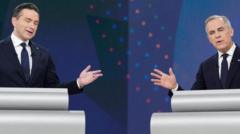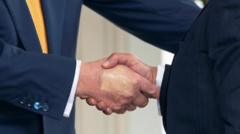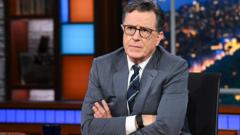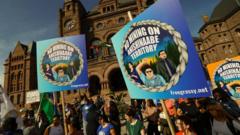In an insightful face-off, Canada’s top party leaders debated crucial topics including trade, crime, and governmental roles, with the shadow of former Prime Minister Justin Trudeau looming over Liberal leader Mark Carney.
Leaders Clash in Canada's Final Election Debate: Key Highlights

Leaders Clash in Canada's Final Election Debate: Key Highlights
Canada's party leaders engage in a spirited debate that emphasizes key issues ahead of the general election.
Leaders of Canada’s four major political parties convened on Thursday for the second and final debate before the general election, with notable attention drifting towards the looming presence of former US President Donald Trump. Liberal leader Mark Carney, who has been leading in the polls, faced tough questioning from Conservative leader Pierre Poilievre, New Democratic Party leader Jagmeet Singh, and Bloc Québécois leader Yves-François Blanchet as they aimed to dissect his policies and connection to Trudeau's past governance.
A significant aspect of the debate concerned an ongoing trade war with the US. While tariffs imposed by the Trump administration were a hot topic, leaders emphasized the need for strategic responses rather than equal retaliation, recognizing the economic disparity between the two nations. Carney noted the shift from a "dollar-for-dollar" tariff strategy to more targeted measures aimed at minimizing damage to the Canadian economy.
Beyond international relations, substantive discussions on domestic concerns arose, including crime and housing affordability. Poilievre promoted a vision of small government and low taxation, while Singh argued for enhanced social programs such as national healthcare initiatives. Each party leader showcased distinct perspectives that illuminate the stark political choices facing Canadian voters.
The debate also highlighted how smaller parties, like Singh’s New Democrats and Blanchet’s Bloc, are exceeding a tough political climate as polls reflect a dominant choice for larger parties. Notably, the New Democrats appear to be struggling significantly, with predictions of a dramatic loss in parliamentary representation.
Despite a climate of spirited debate, a certain measure of Canadian civility prevailed among the leaders. Following tense exchanges, gestures like handshakes and laughter offered a compelling contrast to the often combative nature of political discourse seen in other countries.
With the general election closing in, Canadians are poised to make their decisions based on the leaders’ performances and the issues brought to light during this final debate.





















